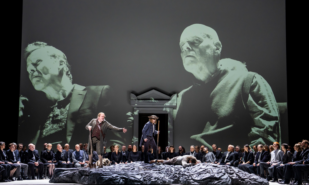This year’s Frieze marked the 20th anniversary of “one the world’s most influential contemporary art fairs” (as its founders humbly describe their project), and the vibes at this utmost esteemed event lived up to the expectations of the single most clueless attender. Frieze 2023 embodied the current state of Britain perfectly — witty but rather sceptical modern art pieces placed between the focused, no-nonsense crowd.
Frieze 2023: Conclusion
Running between October 11th and 15th in its traditional location in Regent’s Park, Frieze London and Frieze Masters were attended by thousands of stylish art enthusiasts from around the world. While the exhibits, provided by a variety of internationally acclaimed gallerists, presented a colourful spectacle of creativity and innovation, some of the attendees’ fashionably imaginative attires appeared as a perfect addition to the fair’s heightened atmosphere.
The fair was attended by a number of A-list celebrities including Michael Bloomberg, Rami Malek,
Andrew Garfield, FKA Twigs, Kim Catrall, Raf Simmons, Florence Pugh, the mayor of London Sadiq Khan and artist Tracey Emin, whose recent work was also exhibited at Frieze this year.
Although the prime minister Rishi Sunak, a known art collector, was not able to join the exclusive VIP preview event, he recently hosted a group of UK arts leaders at 10 Downing Street in a symbolic gesture of support for the country’s art market.
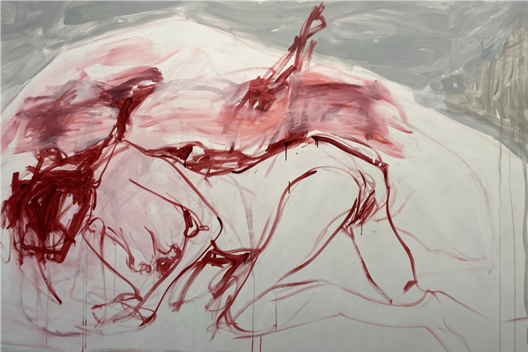
Big sales were reported at Frieze this year with a number of sold-out booths. Gagosian sold out its solo presentation of 12 paintings by Damien Hirst at Frieze on the fair’s opening day. Pace sold out its Frieze Masters display of sculptures by Arlene Shechet, priced between $65,000 and $90,000 per piece. London gallery Harlesden High Street — making its Frieze debut this year — sold out its booth, which included multiple paintings by Hamed Maiye for £7,500 ($9,109) each, and several paintings by Mattia Guarnera-MacCarthy for £5,000 ($6,070) each, which sold within the first 10 minutes of the fair.
Notably, two of the biggest reported sales this year were sculptures by late female artists — Louise Bourgeois’s Knife Work (1949), which went for £3 million, and Louise Nevelson’s sculpture Model for Celebration II (1976), sold for £2 million.
As usual, despite the saturation with talent and fresh artistic vision, Frieze definitely had its favourites this year. Spread over Frieze London and Frieze Masters, certain booths were at times almost impossible to drop in, so busy they were with excited guests.
Sophie von Hellermann’s breathtaking solo booth with Pilar Corrias Gallery at the very entrance of the Frieze London fair stole the show. The nine-painting series depicting a colourful, ethereal setting of the century-old amusement park Dreamland in Margate attracted visitors with the light and glowing atmosphere. This experience was enhanced by the booth’s entourage of walls decorated by the artists with brushy swaths of purples, mauves and blues, accompanied by a rainbow-coloured carpet designed Sophie von Hellermann as well.
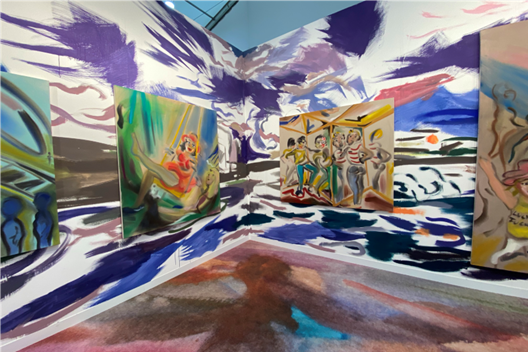
New Dehli gallery Nature Morte received a large amount of praise from the public for its group presentation of several handmade craft works by artists from India and the diaspora. A highlight was certainly a sculpture by Subodh Gupta Stitching the code (II) (2022-23), composed from an oldfashioned pedal sewing machine, positioned as if in the middle of stitching through reams of material made of smashed porcelain plates.
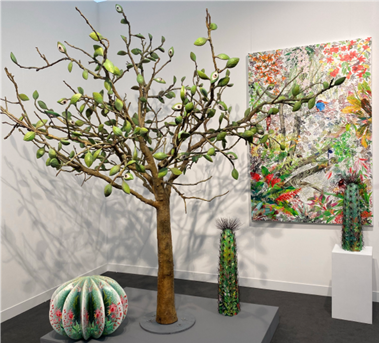
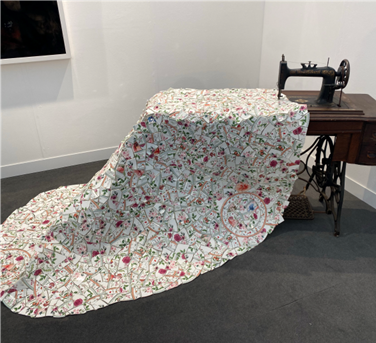
Another one of this year’s Frieze favourites undeniably was Timothy Taylor’s booth and the catroon-esque works of Eddie Martinez that covered every millimetre of the booth’s walls. While most of the exhibited work was not for sale, witnessing this installation was a priceless visual experience. With the telltale, jigsaw-puzzle edges of ring binder notebooks, many of these drawings are done in a single color. Others have a mix of shades, bright swishes of childlike blue, red, or green, showing the progression of thought in the artist’s mind from sketch to finished painting.

In the focus section of Frieze Masters, designated for galleries in business for 13 years or less, Los Angeles dealer Nonaka Hill presented a series of works by Japanese painter Zenzaburo Kojima, introducing a new vision of the 20th century art in Japan. As an acclaimed pre-war artist, Kojima’s work appears in multiple museums across Japan and can even be found on national postage stamps. Influenced by the painterly traditions of East and West, Kojima worked in a modernist style, blending spirited Japanese scenery with colours and shapes of European post-impressionists.
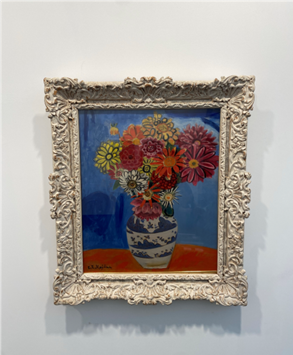
Additionally, there were some individually popular works that drew major attention of the attenders.
These included the 1964 painting by Marc Chagall Le Parade au Village exhibited at the entrance at Frieze Masters, a private collection of Pieter Brueghel the Younger, one of Grayson Perry’s most recent works, and a recent painting of Billy Childish, a multidisciplinary artist that has been prolific in creating music, writing and visual art, provided by Carl Freedman Gallery.

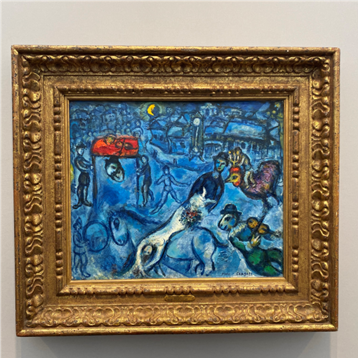
Despite the enthusiasm witnessed among the many fair attenders, a wave of criticism emerged surrounding the event and its exhibits. Some of these were directed at certain artists like Damien Hirst, whose works were deemed as “lazy” and “tasteless” despite selling out completely during the first day, and Marina Abramovic, whose work didn’t attract too much attention and was even referred to as “sad too see [her] like this these days” by an anonymous attender.
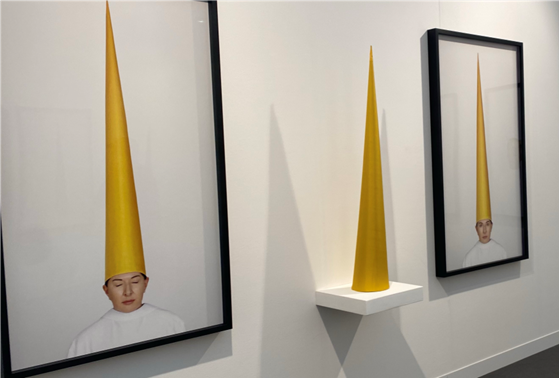
Other critique came from those concerned with the current geopolitical situation in the world.
Gallerists, expecting the worst from sales this year in the light of the most recent global challenges — the Covid pandemic, the war in Ukraine and conflicts in Gaza —, opted for safer choices by predominantly showcasing blue chip works from artists with established markets. This take has place to exist since Frieze has been promoting itself as a platform where the new and lesser known contemporary artists get a chance to show off their work.
In conclusion, it is safe to say that Frieze’s success on the financial side of things was a success — as always. But it is hard to say the same about the mission of bringing new names, art trends and the co-creating breath of fresh air into the contemporary art scene.




